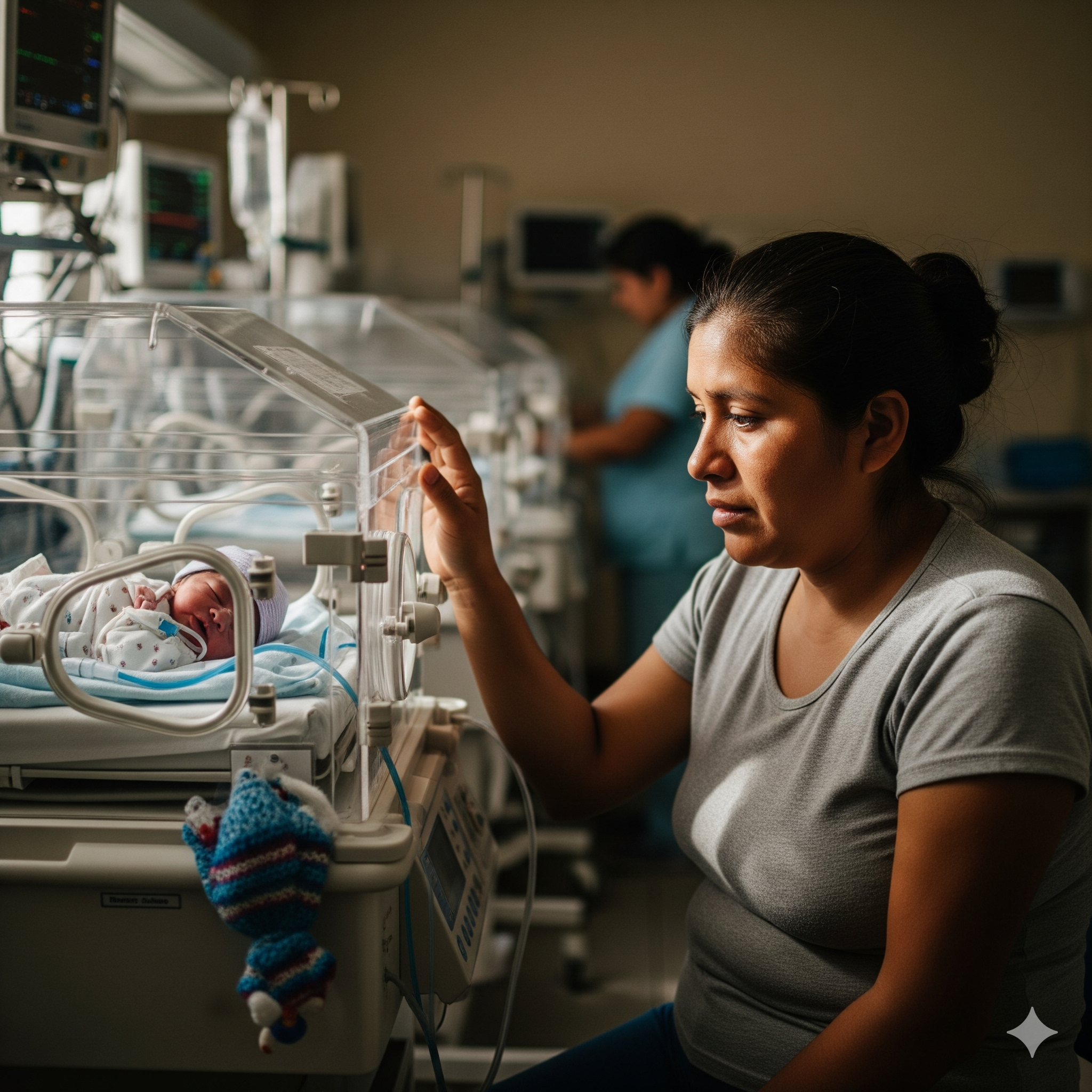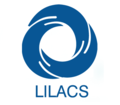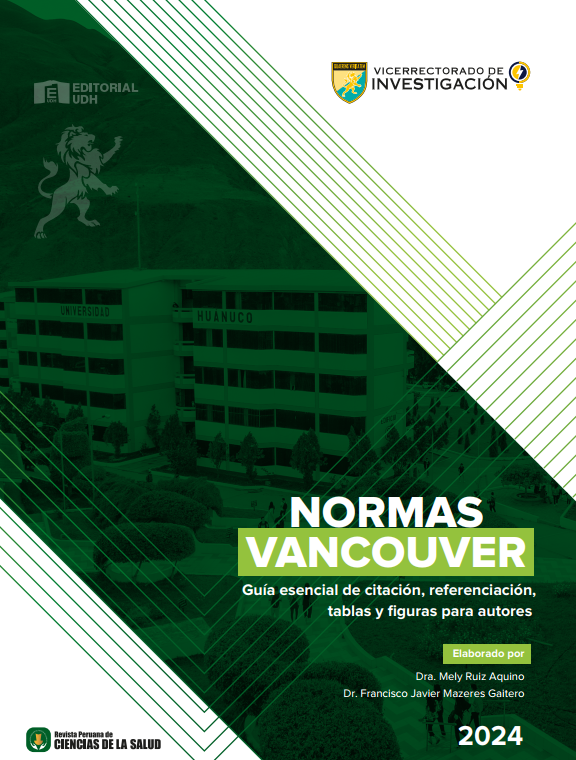Sociodemographic characteristics and postpartum depression among mothers of neonates in intensive care, Peru, 2024
DOI:
https://doi.org/10.37711/rpcs.2025.7.3.9Keywords:
depression, Mothers, neonate, intensive care, public healthAbstract
Objective. To determine the sociodemographic characteristics associated with postpartum depression among mothers of neonates admitted to the intensive care unit of Hospital Nacional Guillermo Almenara Irigoyen, Lima (Peru), 2024. Methods. A quantitative, non-experimental, comparative, cross-sectional study was conducted. The census sample consisted of 180 mothers of neonates in intensive care. The Edinburgh Postnatal Depression Scale (EPDS) was used as the measurement instrument. For inferential analysis, chi-square and Kendall’s tau-b tests were applied. Results. Overall, 47.7 % of mothers were between 28 and 36 years old, 72.2 % were employed, 78.3 % were born in and resided in Lima, and 97.8 % reported having access to basic services. Postpartum depression was present in 60.6 % of the study population. There was a significant association between postpartum depression and age (p = 0.034) and place of residence (p = 0.001). Conclusions. Age and place of residence were the sociodemographic characteristics significantly associated with postpartum depression among mothers of neonates admitted to the intensive care unit of Hospital Nacional Guillermo Almenara Irigoyen.
Downloads
References
1. Dimcea DA-M, Petca R-C, Dumitrascu MC, Sandru F, Mehedintu C, Petca A. Postpartum Depression: Etiology, Treatment, and Consequences for Maternal Care. Diagnostics [Internet]. 2024 [Consultado el 12 de junio de 2025];14(9):865. doi:10.3390/diagnostics14090865
2. Tambelli R, Tosto S, Favieri F. Psychiatric Risk Factors for Postpartum Depression: A Systematic Review. Behavioral Sciences [Internet]. 2025 [Consultado el 12 de junio de 2025];15(2):173. doi:10.3390/bs15020173
3. Dessì A, Pianese G, Mureddu P, Fanos V, Bosco A. From Breastfeeding to Support in Mothers’ Feeding Choices: A Key Role in the Prevention of Postpartum Depression? Nutrients [Internet]. 2024 [Consultado el 14 de junio de 2025];16(14):2285. doi:10.3390/nu16142285
4. Yaqoob H, Ju X, Bibi M, Anwar S, Naz S. A systematic review of risk factors of postpartum depression. Evidence from Asian culture. Acta Psychologica [Internet]. 2024 [Consultado el 16 de junio de 2025];249:104436. doi:10.1016/j.actpsy.2024.104436
5. Zhang Y, Liu X, Liu M. Multidimensional influencing factors of postpartum depression based on the perspective of the entire reproductive cycle: evidence from western province of China. Soc Psychiatry Psychiatr Epidemiol [Internet]. 2024 [Consultado el 16 de junio de 2025];59:2041–2048. doi:10.1007/s00127-024-02686-2
6. Froeliger A, Deneux-Traraux C, Loussert L, Bouchghoul H, Madar H, Sentilhes L. Prevalence and risk factors for postpartum depression 2 months after a vaginal delivery: a prospective multicenter study. American Journal of Obstetrics and Gynecology [Internet]. 2024 [Consultado el 16 de junio de 2025];230:S1128-S1137. doi:10.1016/j.ajog.2023.08.026
7. Leveau-Bartra H, Chávez-Navarro J, Calle-Vilca L, Guerrero-Ortiz H, Mejia-Lengua C, Luján-Divizzia B, Leveau-Vásquez I, Medina-Vásquez N, Leveau-Vásquez H, Medina-Vásquez F. Factores asociados a la depresión posparto en puérperas de un hospital peruano. Clínica e investigación en Ginecología y Obstetricia [Internet]. 2024[Consultado el 17 de junio de 2025];51:100986. doi:10.1016/j.gine.2024.100986
8. Ramos M, Rivera L. Asociación entre depresión postparto y apoyo de la pareja en un centro materno infantil de Lima. Anales de la Facultad de Medicina [Internet]. 2022 [Consultado el 17 de junio de 2025];83:19-24. doi:10.15381/anales.v83i1.20562
9. Antúnez M, Martín N, Casilari J, Mérida F. Depresión posparto, análisis de los factores de riesgo y la intervención de Enfermería. Revisión bibliográfica. Enfermería Cuidándote [Internet]. 2022 [Consultado el 17 de junio de 2025];5:19-29. doi:10.51326/ec.5.3.2558670
10. Alhaj Ahmad M, Al Awar S, Sayed Sallam G, Alkaabi M, Smetanina D, Statsenko Y, Zareba K. Biopsychosocial Predictors of Postpartum Depression: Protocol for Systematic Review and Meta-Analysis. Healthcare [Internet]. 2024 [Consultado el 17 de junio de 2025];12(6):650. doi:10.3390/healthcare12060650
11. Kim H. Predictive Analysis of Postpartum Depression Using Machine Learning. Healthcare [Internet]. 2025 [Consultado el 18 de junio de 2025];13(8):897. doi:10.3390/healthcare13080897
12. Cho M, Lee MH. Predictors of Postpartum Depression in Korean Women: A National Cross-Sectional Study During the COVID-19 Pandemic. Healthcare [Internet]. 2025 [Consultado el 18 de junio de 2025];13(10):1128. doi:10.3390/healthcare13101128
13. Schenker J, Rumrill, Jr. P. Causal-comparative research designs. Journal of Vocational Rehabilitation [Internet]. 2004 [Consultado el 18 de junio de 2025];21(3):117-121. doi:10.3233/JVR-2004-00260
14. Savitz D, Wellenius G. Can Cross-Sectional Studies Contribute to Causal Inference? It Depends. American Journal of Epidemiology [Internet]. 2023 [Consultado el 19 de junio de 2025];192:514-516, doi:10.1093/aje/kwac037
15. Rahman MM. Sample size determination for survey research and non-probability sampling techniques: A review and set of recommendations. J Entrep Bus Econ [Internet]. 2023 [Consultado el 19 de junio de 2025];11(1):42-62. https://scientificia.com/index.php/JEBE/article/view/201
16. Cox J, Holden J. Detection of postnatal depression. Development of thee 10-item Edimburg Postnatal Depression Scale. The British Journal of Psychiatry [Internet]. 1987 [Consultado el 19 de junio de 2025];150:782-786. doi:10.1192/bjp.150.6.782
17. Schreiber J. Issues and recommendations for exploratory factor analysis and principal component analysis. Research in Social and Administrative Pharmacy [Internet]. 2021 [Consultado el 19 de junio de 2025];17:1004-1011. doi:10.1016/j.sapharm.2020.07.027
18. Campos-Marin Á, García-Muñoz C, Matias-Soto J, Martinez-Calderon J. What Interventions Focused on Physical Activity Could Improve Postpartum Depression Symptoms? An Overview of Systematic Reviews with Meta-Analysis. Healthcare [Internet]. 2025 [Consultado el 20 de junio de 2025];13(12):1419. doi:10.3390/healthcare13121419
19. Rodríguez-Gallego I, Vila-Candel R, Corrales-Gutierrez I, Gomez-Baya D, Leon-Larios F. Evaluation of the Impact of a Midwife-Led Breastfeeding Group Intervention on Prevention of Postpartum Depression: A Multicentre Randomised Clinical Trial. Nutrients [Internet]. 2024 [Consultado el 20 de junio de 2025];16(2):227. doi:10.3390/nu16020227
20. Tzitiridou-Chatzopoulou M, Orovou E, Zournatzidou G. Digital Training for Nurses and Midwives to Improve Treatment for Women with Postpartum Depression and Protect Neonates: A Dynamic Bibliometric Review Analysis. Healthcare [Internet]. 2024 [Consultado el 20 de junio de 2025];12(10):1015. doi:10.3390/healthcare12101015
21. Bradshaw H, Riddle J, Salimgaraev R, Zhaunova L, Payne J. Risk factors associated with postpartum depressive symptoms: A multinational study. Journal of Affective Disorders [Internet]. 2022 [Consultado el 20 de junio de 2025];301:345-351. doi:10.1016/j.jad.2021.12.121
22. Agrawal I, Mehendale A, Malhotra R. Risk Factors of Postpartum Depression. Cureus [Internet]. 2022 [Consultado el 20 de junio de 2025];e30898. doi:10.7759/cureus.30898
23. Tsai J, Tsai L, Tsay S, Chen Y. The prevalence and risk factors of postpartum depression among women during the early postpartum period: a retrospective secondary data analysis. Taiwanese Journal of Obstetrics and Gynecology [Internet]. 2023[Consultado el 21 de junio de 2025];62:406-411. doi:10.1016/j.tjog.2023.03.003
24. Dubey A, Chatterjee K, Chauhan V, Sharma R, Dangi A, Adhvaryu A. Risk factors of postpartum depression. Industrial Psychiatry Journal [Internet]; 2021 [Consultado el 21 de junio de 2025];30:127-131. doi:10.4103/0972-6748.328803
25. Liu X, Wang S, Wang G. Prevalence and Risk Factors of Postpartum Depression in Women: A Systematic Review and Meta-analysis. Journal of Clinical Nursing [Internet]. 2021 [Consultado el 21 de junio de 2025];31:2665-2677. doi:10.1111/jocn.16121
26. Putri A, Wurisastuti T, Suryaputri I, Mubasyiroh R. Postpartum Depression in Young Mothers in Urban and Rural Indonesia. Journal of Preventive Medicine & Public Health [Internet]. 2023 [Consultado el 21 de junio de 2025];56:272-281. doi:10.3961/jpmph.22.534
27. Chen L, Shi Y. Analysis of influencing factors and the construction of predictive models for postpartum depression in older pregnant Women. World Journal of Psychiatry [Internet]. 2023 [Consultado el 21 de junio de 2025];13:1079-1086. doi:10.5498/wjp.v13.i12.1079
28. Handelzalts J, Ohayon S, Levy S. Risk psychosocial factors associated with postpartum depression trajectories from birth to six months. Soc Psychiatry Psychiatr Epidemiology [Internet]. 2024 [Consultado el 21 de junio de 2025];59:1685-1696. doi:10.1007/s00127-023-02604-y
29. Brandao T, Ribeiro AC, Griff MI, Babore A, Diniz E. Social Support and Postpartum Depressive Symptoms in Portuguese Women: The Mediating Role of Emotion Regulation Difficulties. Journal of Clinical Medicine [Internet]. 2024 []Consultado el 16 de agosto de 2025];13(23):7150. doi:10.3390/jcm13237150

Downloads
Published
Issue
Section
License
Copyright (c) 2025 Rosana Haro-Norabuena, Zoila Moreno-Garrido

This work is licensed under a Creative Commons Attribution 4.0 International License.





















